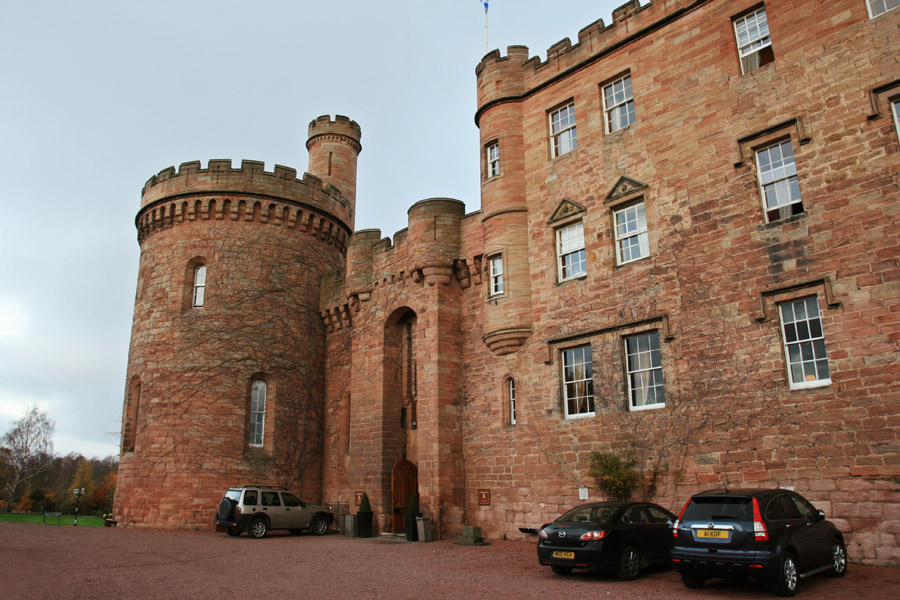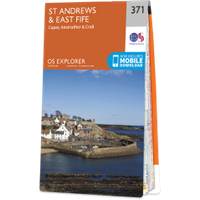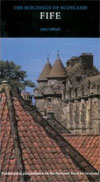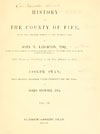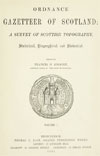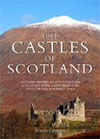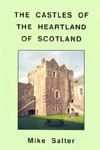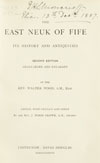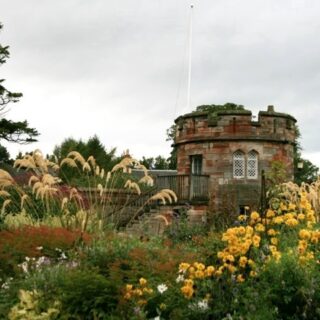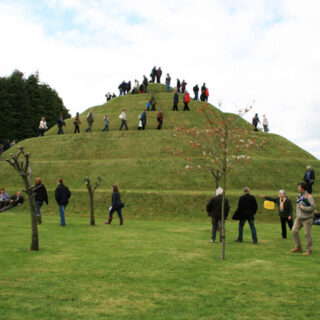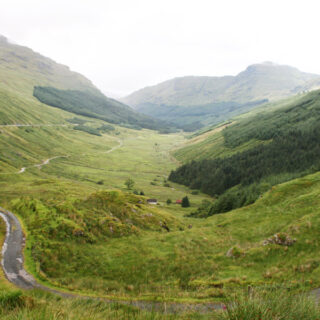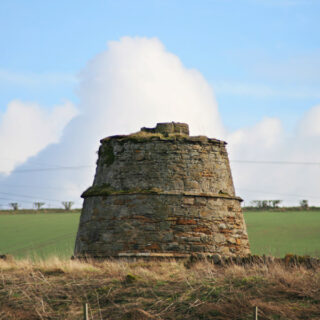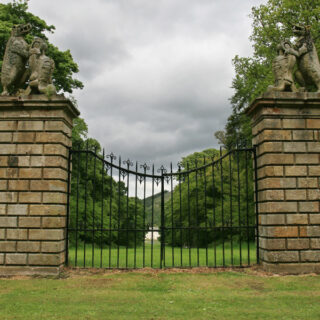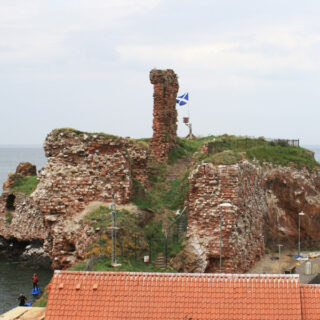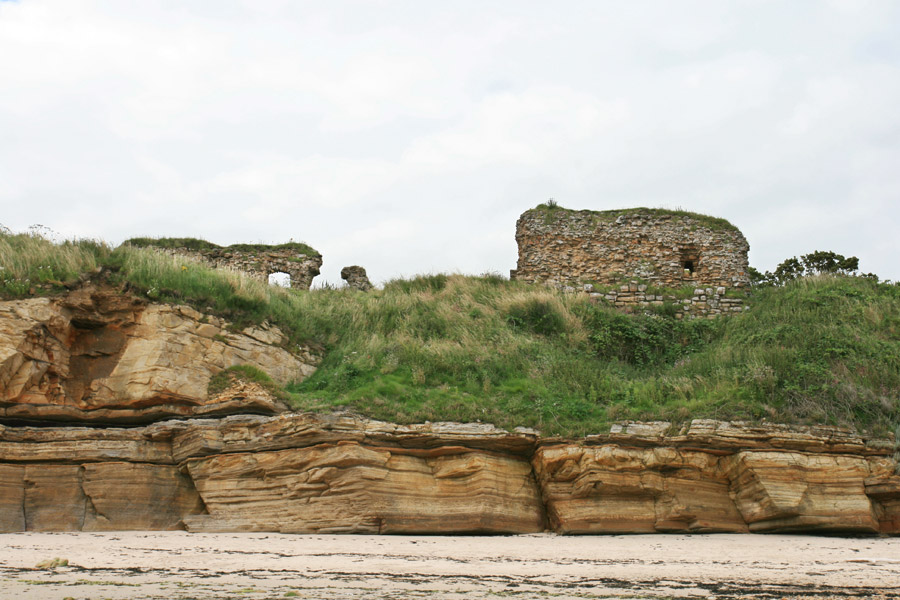

The ruins of Ardross Castle, dating back to at least the 15th century, occupy a fine defensive coastal position standing high on sandstone cliffs overlooking a sandy beach below.
In 1068 a Northumbrian knight named Merleswain came to Scotland and was granted lands in this area of the south-east coast of Fife, which later passed to his son, Colbán and grandson, also Merleswain, Lord of Kennoway and Ardross. The younger Merleswain’s son, another Merleswain, witnessed charters by Richard the Chaplain, Bishop of St Andrews, in the third quarter of the 12th century and was granted a charter of Ardross by William the Lion in the last quarter of the same century.
Ardross was the old name for the estate of what is now known as Elie, and was bounded by the lands of Newark to the north-east, Sandford to the west, and Kilconquhar and Balbuthie to the south-west.
Towards the end of the 12th century Merleswain’s son, Waltheof, inherited Ardross, Fethkill and Kennauchy and his possessions also included Kincraig, Sandford and Elie.
Waltheof’s son, another Merleswain, was described as lord of Invergelly and died around 1250 leaving three daughters, Scolastica, Margaret of Ardross and Ela of Ardross. Judging by later references to subdivisions of some of his lands it is likely that his estates were split into three parts and distributed between his daughters as as co-heiresses.
Margaret of married Hugh de Pearsby, Sheriff of Roxburgh, and in September 1281 granted the lands of Innergelly to Dryburgh Abbey. By 1295 she had married again, this time to Sir John de Soulis or Soules, one of the ambassadors to France who helped arrange the marriage between Alexander III and Yolande de Dreux.
Soulis died in 1318, and the estate seems to have become the property of John Burnard, from the family of Burnard of Leys (later Burnetts of Leys).
An Andrew de Kandell, possibly a member of the de Candela family of Anstruther, was proprietor of part of Ardross in 1366 however this doesn’t appear to have been the main part of the estate as Burnard granted the lands of Ardross to a William Dishington who is described as Burnard’s heir in a charter of 1368.
Sir William Dishington married Elizabeth Bruce, sister of Robert the Bruce, around 1309, and one of their sons, also Sir William Dishington, later became the Sheriff of Fife. Some histories have the first Sir William as the builder of Ardross Castle, while some suggest it was the second Sir William. Although the remains of the castle have often been ascribed to the 15th century, it seems entirely possible that it was built at an earlier date, and for either Sir William to have been responsible it would certainly have been built in the 14th century.
Indeed in 1402 the second Sir William’s son, Thomas Dishington, received a charter from Robert II granting him the barony and castle of Ardross after they were resigned by his father, while also referring to him as “dilecto nepoti nostro” (our dear nephew). The fact that the castle is specifically mentioned certainly suggests it was in existence in the 14th century.
It is said that the earlier Sir William played host to David II and his Queen, when they were shipwrecked on Lady’s Rock while crossing the Firth of Forth from North Berwick to Earlsferry in 1362. However David’s first wife, Joan of England, apparently remained in England when her husband returned to Scotland following his release from captivity in 1357. He married Margaret Drummond, daughter of Sir Malcolm Drummond, the 10th Thane of Lennox, but not until 1364. So something with this story doesn’t seem to quite add up.
Considering the apparent age and importance of the barony, it seems likely that this 14th century building work either replaced an earlier building, or incorporated part of it into its structure.
The castle seems to have originally consisted of a single strong tower, the north-easterly of the two buildings visible on the site today, probably built in the mid to late 14th century. Aligned approximately north-east to south-west, roughly following aligned with the edge of the cliffs, the tower is rectangular in form, measuring around 11.2m north-east to south-west by around 8.8m north-west to south-east. The walls are massively thick, at between 1.9 to 2.1m wide.
Access to the lower level of this tower is via a doorway in the south-west gable. Within the thickness of the wall running north-west away from the door is a staircase which starts off straight but then becomes a turnpike, possibly a later addition leading up to the first floor. It may be that the doorway itself, which features a moulded door jamb, is also a later addition, with there perhaps being no external access to the ground floor originally.
The interior of the ground floor level measures around 5.0m by around 7.1m, and was vaulted. Although the roof and everything above it have long since fallen, the beginnings of the vaulting can be seen curving upwards.
In the south-east wall is a narrow window, just 14cm wide, looking out over the Firth of Forth. There is a second window in the north-east gable, slightly higher up the wall. Within each gable is an aumbry. Against the north-west wall is what are thought to be the remains of a service stair leading up to the main hall on the first floor.
Excavation has shown that a smaller building was built against the outside of the north-east gable. Measuring around 8.0m square, it had walls approximately 0.8m thick. What it looked like or what purpose it served is unclear, as the walls now only stand to a height of around 0.8m.
To the south-west of this tower, and running on a similar but slightly different alignment, are the ruins of a second building. Thought to have been built in the 16th century, this block measures approximately 23.8m north-east to south-west by around 5.8m north-west to south-east, with walls around 1.8m thick. It seems to have been attached to its neighbour, as a small section of connecting wall survives.
This longer building is rather notable for having six large arched openings in its south-east wall, looking out over the sea. Three of these have been interpreted as windows, while some or all of the others may have been doors. The opening at the south-west end of the wall seems to have been a doorway leading into an external turnpike stair tower projecting to the south-east.
Although far from clear, this building may have been vaulted. It has suffered greatly from having stone robbed from it, and what is left is actually the rubble core. Most of the facing stones have been removed, and similar stone can be seen in the neighbouring farm buildings.
Around 100m to the north-west of the castle is a dovecot which is variously considered to be either 17th century or early 18th century in date.
Ardross Castle remained in the Dishington family until either 1607 or 1611 (depending on the source) when Thomas Dishington sold “the lands and barony of Ardross with the fortalice and manor-place” to Sir William Scott, later of Elie.
Dishington had married, in 1598, Scott’s daughter Elizabeth, and in the same year he sold Scott the wester half of Ardross, known as The Elie, for 37,000 merks. In 1611 he bought the easter half of Ardross for 85,700 merks. Scott died in 1628, and was succeeded by his son, also Sir William.
In 1661 Sir William Scott of Ardross is listed as a witness in the treason trial of Archibald Campbell, the 1st Marquis of Argyll, having apparently witnessed Argyll’s burning of Menstrie Castle.
Some time around 1690 Sir William Anstruther of Anstruther bought the lands of Ardross, together with those of Elie, Bruntshiels, Muircambus and Carmurie. In 1694 he was granted a charter by Queen Anne “of the baronies of Anstruther and Ardross, with many other lands”.
Anstruther’s focus seems to have been on Elie House rather than Ardross Castle, where he commissioned a grand new house to be built.
In 1853 Sir Wyndham Anstruther sold the Elie estates to William Baird, son of Alexander Baird of Lockwood, and as such Ardross Castle became his property.
Following Baird’s death in 1864, the Elie estates, including Ardross Castle, passed to his son, William Baird of Elie.
In 1928 the estates were sold to Sir Michael Nairn, 2nd Bt., and they are now owned by the Elie Estate Trust, which is under the stewardship of Sir Michael’s grandson, Sir Michael Nairn, 4th Bt..
The Fife Coastal Path passes through the ruins of Ardross Castle, between the two buildings, and so it is freely accessible.
Alternative names for Ardross Castle
Ardors; Ardros; Ardrosse; Old Ardross
